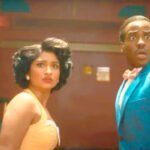“The Talons of Weng Chiang”… even the very mention of the title instils wonder into the minds of Doctor Who fans. The mist, the Victorian setting, the Eye of the Dragon, the Peking Homunculus – they are all icons of Doctor Who. Like Pyramid from Mars and Spearhead from Space earlier, Robert Holmes crafted a story perfect for scaring the viewers while at the same time providing interesting character development and a challenge for our hero and his companion at every turn.
The Foe from the Future was the title of the original storyline, written by Robert Banks Stewart. The writer had previously has success with the stories Terror of the Zygons and The Seeds of Doom, both seminal Doctor Who stories. However on this occasion, Stewart was unable to complete the script, which resulted in Robert Holmes stepping in to complete the task.
Talons was one of the series last 6-part stories, and unlike Invasion of Time and The Armageddon Factor, the story is perfectly plotted and directed. Previous problems with six-parters containing a couple of episodes of padding are simply not present as the Doctor and Leela get to grips with Li H’sen Chang and his deranged master, Magnus Greel.
Magnus Greel… a time-travelling foe from the 51st Century whom the Doctor had encountered (albeit indirectly) on a previous occasion. An interesting character, father of the Zigma experiment and the Peking Homunculus; Magnus Greel was one of the first instances of non-Gallifreyan time-travellers in Doctor Who. While The Talons of Weng Chiang is renowned for its visual iconography (the mist, the Doctor’s Deerstalker, Litefoot’s House and of course the stunning theatre…), the story itself – fantastic as it is – doesn’t seem to have had much impact on future Doctor Who. Whereas Robert Holmes’ previous story The Deadly Assassin had a massive impact on Who mythology, spawning the Time Lord Chapters, Panopticon, Eye of Harmony, Amplified Panatropic Computer Network (or Matrix) and questionable head-dresses, Talons managed to have the singular impact of Doctor Who avoiding another Victorian London setting for the rest of the show’s run.
Despite this, however, what Talons misses out on in influencing future Doctor Who mythology, it more than makes up for in characterization. With dialogue triumphs such as “Sleep is for Tortoises” gleaming brightly, let us step to one side and examine one particularly complex character…
“Scares me witless, I can tell you sir. Those eyes, so controlling and unnerving. Why, I swear he was looking into my soul itself! Anyways, the next night, I heard of all sorts of goings on in that very theatre! Who would have thought that such a gentle oriental could be involved in such deeds?”
Anonymous Limehouse Bystander
Who indeed? So mild-mannered, yet strangely aloof, Li H’sen Chang is one of Doctor Who’s more interesting villains. As servant to his god Weng Chiang, Chang is the perpetrator of ghastly crimes against women. Under cover of a theatrical act – a hypnotist – Chang is able to seduce the women to surrender the bodies to unspeakable vampirism.
Aided by the Peking Homunculus, Chang is also the representative of his god Weng Chiang to his compatriots living and working in 19th century London. As such he is in demand with the Police for matters of translation in whatever scrapes the immigrants might get themselves into.
So, a figure of respect, intelligence and gifted amazing powers steals women from the night streets to allow his god to feed from their life essence. Li H’sen Chang could be described as a monster in the truest sense of the word. He has no feelings for his fellow humans, no pity. There is no depth to which he will sink to aid his god, no task he would turn down. Gifted extraordinary mental powers by Weng Chiang, he uses them not for good but to follow his twisted master’s bidding.
John Bennett, the actor who turned Li H’sen Chiang into a three dimensional character and not another ciphered Chinaman, had previously appeared in Doctor Who as General Finch in Invasion of the Dinosaurs. He is an actor of standing in the industry, having worked almost constantly since the early 1960s – recent work has included “The Fifth Element” (1997), “Heartbeat” (1999), “The Pianist” and “Minority Report” (both 2002). While most productions at the BBC in the second half of the 1970s shied away from employing actors of one race to portray a character of another, the production team (Producer Phillip Hinchcliffe and Script Editor Robert Holmes) wisely chose against Burt Kwouk (at this point in time rumoured to be the only oriental actor in Britain with an Equity card).
So with a little makeup, and a suitable attention to detail, John Bennett turns Li H’sen Chang into a selfish, god-fearing puppet, happy to obey his master’s disgusting commands – blind to the truth, yet it stares him in the face…
Perhaps mention should be made of the Peking Homunculus. What we’re talking about here, for the uninitiated, is a robot with the brain of a pig. A very bloodthirsty robot, hell-bent on death and destruction that looks like a ventriloquist’s dummy. Another example of Robert Holmes’ fantastic mind as a writer, the Peking Homunculus is possibly the one aspect of Talons that could have been revisited at some point in the future. “Disturbing” is possibly the only word to describe the creature. But it is also a wonderful creation, given an excellent bit of history when the Doctor reveals it was given as a present to the children of the Commissioner of the Icelandic Alliance, thus starting World War 6.
It took a giant rat in a dark sewer to open Chang’s eyes, for him to see the light. As he lies on his death bed smoking opium we learn that Chang – a mere peasant – was given those powers by his god Weng Chiang. The foe from the future transformed a young Chinese peasant into his tool, to help him search for the time cabinet so that he might return to his own time. Sick, close to death, ravaged by radiation, Weng Chiang – in reality Icelandic war criminal Magnus Greel – has used Chang’s acute faith in his god Weng Chiang and perverted it.
Characters of this depth – and performances of this calibre – would rarely be seen again in Doctor Who. Despite its obvious strengths, The Talons of Weng Chiang has curiously managed to leave only visual footprints on the Doctor Who universe. Its impact was so strong, no one dared touch Victorian London with a bargepole…
Discover more from Kasterborous
Subscribe to get the latest posts sent to your email.









